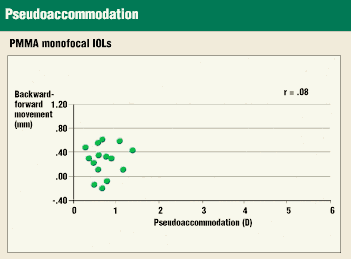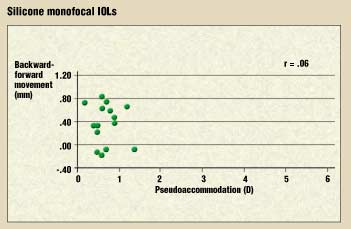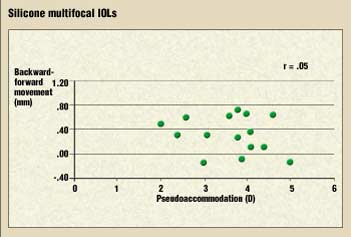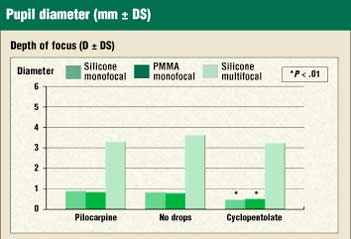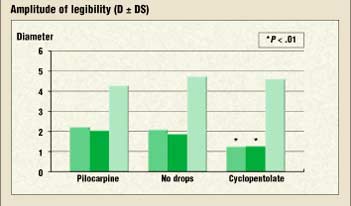Blur circles determine range of pseudoaccommodation
The size of blur circles on the retina seems to be connected with the ability to focus on near objects.
TRIESTE, Italy – The range of pseudoaccommodation in eyes implanted with monofocal IOLs may be determined by the dimension of blur circles in the retina, according to a study by Fabio Baccara, MD. In addition, the same optic phenomenon may be connected to successful results with near vision in multifocal lenses, he said.
“There are various factors, such as myopic astigmatism, pupil diameter, IOL design and backward and forward movement of the lens, which have traditionally been connected with pseudo accommodation,” Dr. Baccara said. “We have evaluated the incidence of some of these factors.”
His study showed that pseudoaccommodation is less related to the movement of the IOL and more related to the way light reaches the retina after traveling through the eye’s optical system.
Dr. Baccara and colleagues evaluated aspects of pseudoaccommodation in 50 patients implanted with monofocal silicone Allergan SI40NB IOLs, 50 patients implanted with monofocal PMMA Pharmacia 809C IOLs and 50 patients implanted with multifocal silicone Allergan Array SA40NB IOLs. All patients included in the study had corrected visual acuity of 20/25 or better, refractive error within 1 D of emmetropia, no astigmatism and axial lengths of between 22.8 mm and 23.6 mm, Dr. Baccara said.
|
|
Range of pseudoaccommodation
Clinical parameters of the study included depth of focus as measured with Duane test, amplitude of legibility based on the 3rd Jaeger character, and anterior chamber depth measured with A-scan.
“Measurements were first carried out in normal pupil conditions, then 30 minutes after instillation of 2% pilocarpine and cyclopentolate on two different days,” Dr. Baccara said.
In normal pupil conditions, the Duane test revealed a low depth of focus, within 1 D, in patients implanted with monofocal IOLs.
“The Duane test, which is more sensitive and precise, revealed a lower range of pseudoaccommodation than the Jaeger test, which showed an amplitude of legibility acuity within 2 D. With multifocal IOLs, on the other hand, both depth of focus and amplitude of legibility had a wider range of around 3 D,” he said.
After pupil dilation, depth of focus was reduced to about 0.5 D in the monofocal groups. The difference was statistically significant. Amplitude of legibility was lowered from 2 D to 1 D.
|
|
No correlation
“Finally, we evaluated the effects of the backward-forward movement of the lens on pseudoaccommodation. We measured the anterior chamber depth after instillation of pilocarpine and cyclopentolate, which respectively cause contraction and relaxation of the ciliary muscle. The difference between the two values obtained showed the movement range of the lens in each patient,” Dr. Baccara said.
Results did not show a significant correlation between lens movements, which were near zero, and pseudoaccommodation.
“There was no significant positive accommodation that could explain the range of vision achieved by these patients,” he concluded.
Blur circles
The researchers explained that the phenomenon of pseudoaccommodation is related to the imaging of single points of vision on the retina.
“We know that the retinal impression of a point in space is a blur circle — a kind of reflecting, dilated spot with blurred outlines. The smaller these blur circles, the better the transfer of contrast sensitivity, and the better the quality of retinal image,” Dr. Baccara explained. “Therefore, the ability to focus near objects through a correction for distance, is strictly correlated with the dimension of the blur circle.”
Pupil dilation has an effect on the dimension of these blur spots. As the image becomes more out of focus, there is a poorer transfer of contrast sensitivity.
For Your Information:
- Fabio Baccara, MD, can be reached at Clinica Oculistica, Università di Trieste, 34129 Trieste, Italy; +(39) 040 -313833; fax: +(39) 040-772449; e-mail: fbaccara@ adriacom.it. Dr. Baccara has no direct financial interest in any of the products mentioned in this article, nor is he a paid consultant for any companies mentioned.
- Allergan, makers of the Array Multifocal IOL and the SI40NB Monofocal IOL, can be reached at 2525 Dupont Drive, Irvine, CA 92612 U.S.A.; +(1) 714-246-4500; fax: +(1) 714-246-4297; Web site: www.allergan.com.
- Pharmacia, makers of the PMMA 809C IOL, can be reached at 100 Route 206 North, Peapack, NJ 07977 U.S.A.; +(1) 908-901-8000; fax: +(1) 908-901-7700.

